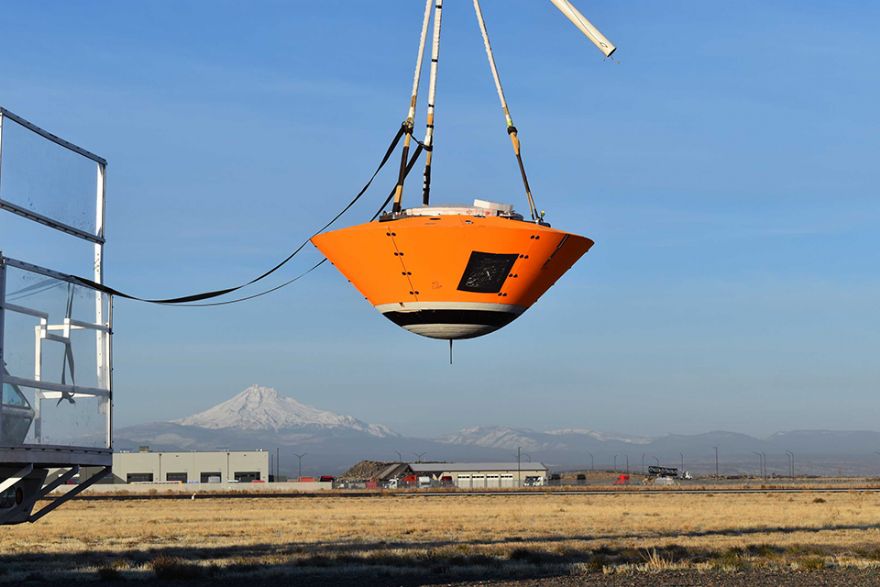
The two parachutes that will safely deliver the UK’s first ever Mars vehicle to the Red Planet have successfully completed their first full-scale high-altitude drop test. Once the
European Space Agency (ESA) ExoMars Rosalind Franklin rover reaches Mars, a dramatic 6min sequence will see a ‘descent module’ – carrying the rover – deploy two parachutes to rapidly slow it down ahead of its landing on the Martian surface.
Atmospheric drag will slow the module from around 21,000kmph to 1,700kmph at which point the first parachute will be deployed. Some 20sec later, at about 400kmph, the second parachute will open. When the module is 1km above ground, the braking engines will kick into gear and safely deliver it to Mars’ surface.
The complete parachute descent system needs testing and verifying on Earth, which can only be done through high-altitude drop tests that replicate conditions of low atmospheric pressure on Mars.
The test – which had been delayed since March due to the Covid-19 pandemic, wind and forest fires – took place over Oregon, USA on 9 November, with a drop test vehicle lofted to a height of 29km in a stratospheric balloon.
The parachute extraction and deceleration proceeded as scientists expected, with the test vehicle landing safely and the parachutes recovered. There was minor ‘canopy damage’ on the two parachutes, occurring at the onset of inflation.
Rosalind Franklin – a joint Europe and Russia mission – will try to detect life, past or present, on the Red Planet and is due for launch in 2022. Completion of the parachute test marks a critical milestone for the rover, which has been built in Stevenage by Airbus, and the team will now analyse test data to determine further improvements for the next tests.
Sue Horne, Head of Space Exploration, said: “Parachute tests are vital in helping us get the technology exactly right and making sure that the Rosalind Franklin rover lifts off with the most advanced and reliable equipment possible.”
Following failed tests of the parachute last year, the first main parachute had an upgraded parachute bag and a Kevlar reinforcement around the vent hem, aka the natural vent hole in the middle of the parachute.
The second main parachute had several reinforcement rings and an upgraded parachute bag, but not reinforced parachute lines, which are also planned.
Once safely in the Oxia Planum region of Mars in June 2023, the Rosalind Franklin rover will drive off the platform and begin its science mission. It will seek out geologically interesting sites to drill below the surface, to determine if life ever existed on our neighbour planet.
UK company, Vorticity Ltd is technical consultant for the parachute system and is responsible for the high altitude drop tests of the parachutes. Vorticity designed and manufactured the parachute test vehicles and then performed the test along with their US subcontractor, Near Space Corporation.
John Underwood, Principal Engineer at Vorticity, said: “This is an enormously challenging programme involving the development of the largest parachute ever sent to Mars. Huge improvements have been made to the system since the tests last year and we are confident that the last issues will be ironed out before the mission launch in 2022.”
Vorticity is a privately owned UK SME which operates as a centre of excellence for aerospace systems engineering consultancy and space systems development.
ExoMars Programme Team Leader Francois Spoto, said: “Landing on Mars is extremely difficult, with no room for error. The latest test was a good step forward but is not yet the perfect outcome we are seeking. Therefore, we will use the extensive test data we have acquired to refine our approach, plan further tests and keep on track for our launch in September 2022.”
In July this year, NASA launched its Perseverance mission, blazing a trail ahead of the launch of the UK-built Rosalind Franklin rover. Perseverance has several science goals for its mission, and is carrying instruments geared to search for the carbon building blocks of life and other microbes and to reconstruct the geological history of the Red Planet.
The idea is that by investigating the presence and history of water on Mars we can begin to consider the question of whether or not life existed there; which in turn would provide powerful evidence of the probability that life exists elsewhere in the universe.